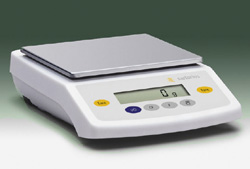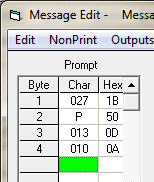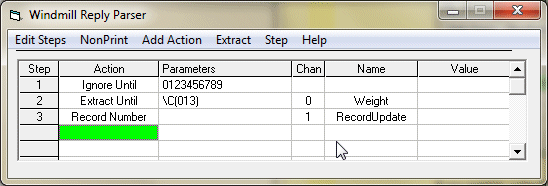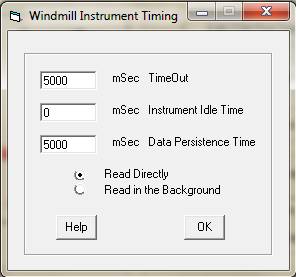Windmill Software Connects Sartorius Balances

Windmill software lets you continually log data from Sartorius balances, and other instruments with RS232, RS485 or TCP/IP serial ports, on a PC running Windows. All data is time-stamped and can be imported into Excel either during or after data collection.
- Run the Windmill ComDebug program and enter your balance's settings.
- Use ComDebug to log data from the balance.
- Optionally, run the Windmill DDE Panel, Logger or Chart program to save or display data from your balance.
Details on entering the Sartorius configuration settings into ComDebug are below.
"Thanks! It worked really well...very happy with the program."
ER, University of Waterloo (Canada)
Note: Sartorius's RS-232 cable has a unique pin out - it is not a standard cable. You need to either purchase the correct cable from Sartorius, or re-wire the connections.
Use ComDebug to enter data about your Sartorius Balance | Data Logging Options | Getting the data into Excel | Trouble-Shooting
Use ComDebug to enter data about your Sartorius Balance
Read this in conjunction with the step-by-step instructions on our Getting Started page. Here we give the specific settings needs for Sartorius balances and scales connected via RS-232.
COM Port Settings
These must be the same as your balance uses. These are the default factory settings for Sartorius Talent, Gem and Gold balances.
| Comm Port: | Select the port to which your instrument is connected. |
| Baud Rate: | 1200 |
| Data Bits: | 7 |
| Parity: | Odd |
| Stop Bits: | 1 |
| Flow Control: | Hardware |
Data Format
Your settings here depend upon how you have configured your balance. In ComDebug's Message Screen, enter a command or prompt string to send to the balance to ask for data. Click the Send button, and the instrument should send a reply (see Trouble-Shooting below if not). Now click the Parse button and enter instructions to extract the data from the balance's reply. These settings work for CP balances. Use the non-print menu to enter the Escape character (027), carriage return (013) and linefeed (010).

| Example prompt command: | Escape followed by P <CR><LF> Use the Non-Print menu to enter the Escape, Carriage Return and Linefeed |
| Example data string: | + 100.0 g<CR><LF> where <CR> is a carriage return and <LF> a linefeed |
| Data format: | ASCII |
| Example parsing: | Ignore Until 0123456789 Extract Until space |

If you want to collect data only when you press a key on the balance, then create an extra channel and Extract the "Record Number" to it. (The record number increments on every new reading, letting the other Windmill programs know that new data is available.)

Instrument Timing
| Read: | Read Directly Choose read directly unless your balance has automatic data output enabled, in which case choose Read in the Background. |
| Timeout: | 5000 ms |
| Instrument Idle or Wait Time: | 0 |
| Data Persistence Time: | 5000 ms |
Further Information:
COM Port Settings
Sartorius Interface Manual
Sartorius Gem and Extend Series Manual
Data Logging Options
For simple logging from one instrument you can use the free ComDebug program. For more logging options from many instruments use the Windmill Logger program.
- Log only when new data is available from your instrument: when a weight changes on a balance for instance. Even if two items weigh the same, Windmill knows that a change has occurred, so no readings are missed.
- Log to a new data file at regular intervals, every hour or every 5 minutes for example. This is useful in continuous, long-term logging.
- Log data only when channels are in an alarm state.
- Log data for a fixed duration, for example during an alarm condition and for ten minutes afterwards.
- Log data when you press the space key on the keyboard
- Use Excel to start and stop logging.
- Log from different channels at different rates.
- Log from different channels to the same or different files.
- Log data from RS232 instruments alongside Modbus and Ethernet devices.
Getting the data into Excel
You can collect data with Excel in real-time, or use the Windmill Logger program to collect data and after collection has finished import it into Excel. For more details see our Excel page.
Trouble-Shooting Sartorius Balances
If you are unable to get data from your balance go back to ComDebug's Terminal screen. Make sure your command is shown in the prompt grid, like in the Message Edit picture above. Click the Send button: does your instrument reply?
- If you only see your command being sent, and no data...
- Make sure that the balance is switched on and plugged into the PC's com (RS232) port.
- Check that the communication settings you entered in ComDebug match those currently in use by the balance: COM port, baud rate, parity, etc.
- If using a USB-RS232 converter, its settings must also match those used by the balance - read the USB-Serial page for details, especially point 7.
- Make sure that the balance is set to ASCII rather than printer mode.
- Check for a cabling problem. Sartorius's RS-232 cable has a unique pin out: it is not a standard cable. You need to either purchase the correct cable from Sartorius, or re-wire the connections. These two tables show the connections for 9-pin and 25-pin cables.
Sartorius Connector Standard RS-232 DB9 Connector Description: Pin# Pin# Description: TxD Output 2 2 RxD Input RxD Input 3 3 TxD Output External Signal
Signal Ground4
145 Signal Ground CTS Input 5 4 DTR Output DTR Output 20 8
CTS
Chassis Ground 1* No Connection
Sartorius Connector Standard RS-232 DB25 Connector Description: Pin# Pin# Description: TxD Output 2 3 RxD Input RxD Input 3 2 TxD Output External Signal
Signal Ground4
147 Signal Ground CTS Input 5 20 DTR Output DTR Output 20 5
CTS
Chassis Ground 1* No Connection
* Optional
For more on pin connections and RS232 see our Serial Port and RS232 Communication page. - If you are still having trouble see our Testing Serial Port Communication section.
- If all else fails fill in our technical support form.
- If you see data but it doesn't make sense, check that your balance's operating mode is ASCII and not Universal Printer. Use the balance's Operating Menu - Data Interface - Communications mode.
- If you have "unstable" conditions and get correct readings when collecting data slowly, but miss readings at higher speeds, you may need to change settings at the balance. For example, when dripping liquid onto the balance it takes a while for the reading to stabilise. In this case try altering the resolution required for the balance to think the reading is stable (on the balance itself, not in Windmill). Otherwise the next drop may arrive before the balance considers itself stable enough to report its reading.
- If, in ComDebug you see data coming in but DDE Panel isn't showing it, you may need to edit your parsing settings. Go to ComDebug's Terminal or Message Screen, click the Parse button. Enter your Ignore and Extract Settings and click the Step menu. Is your data shown in the Value column? If not adjust your settings. See also our Technical Support page.
- If you are getting accurate data readings, but much slower than expected, change your sampling rate. With COMIML, Windmill can make 5 readings per second per channel. So it can record one weight measurement every 0.2 seconds. If you have the sampling interval set much smaller than this, then Windmill may slow down considerably and only make a couple of readings per minute.
Success?
Have you successfully used Windmill with your balance? Let us know about your project.
